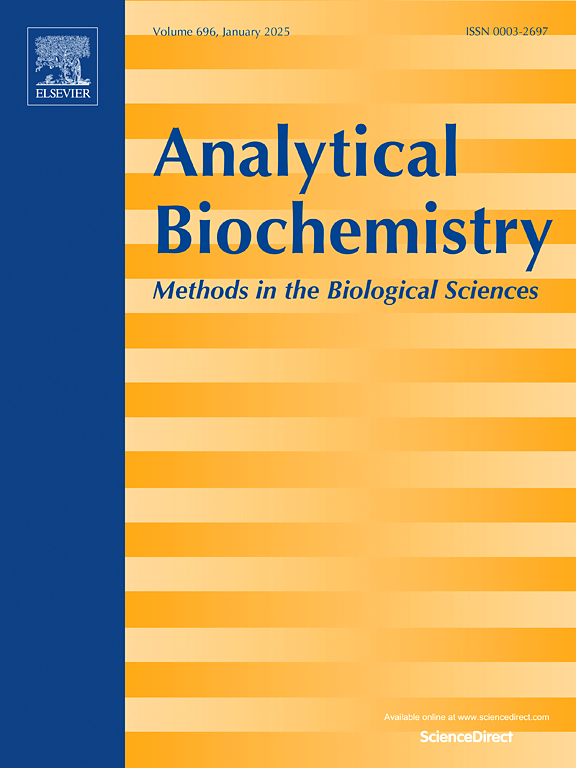Simultaneous multi-element determination in whole blood and urine via dual-mode ICP-MS
IF 2.5
4区 生物学
Q2 BIOCHEMICAL RESEARCH METHODS
引用次数: 0
Abstract
The content of elements in the body has a significant relationship with human health. However, the wide variation in the concentrations of different elements in blood or urine poses challenges for accurate detection. This study presents a dual-mode ICP-MS methodology integrating kinetic energy discrimination (KED) and dynamic reaction cell (DRC) technologies, specifically designed to address the analytical challenge of quantifying 22 physiologically critical elements (Be, V, Cr, Mn, Fe, Ca, Mg, Ba, Co, Cd, Cu, Zn, As, Se, Ti, Sr, Ni, Mo, Sn, Sb, Tl, Pb) spanning six orders of magnitude in concentration (μg/L to g/L) within complex biological matrices. Rejection parameter q (RPq) adjusts the low-mass cutoff, while rejection parameter a (RPa) controls the high-mass cutoff. Optimizing both extends the low-interference dynamic range. The method's core innovation lies in the synchronized optimization of quadrupole parameters RPa and RPq, which enables simultaneous suppression of matrix-derived polyatomic interferences while maintaining linear detector response across ultra-wide dynamic ranges. The method employs a dual-mode analysis approach: (1) In urine analysis, the KED-He mode is suitable for analyzing all elements. (2) In whole blood analysis, DRC-NH3 mode is used for interference-prone elements (Mn, Cr, Ca), and KED-He mode is used for the remaining elements. Strategic optimization of quadrupole rejection parameters (RPa/RPq) achieved intra-day precision of 0.5–7.2 % (blood) and 1.6–5.5 % (urine), with inter-day variations ≤9.6 %, demonstrating robust performance for multi-element profiling across clinically relevant concentration ranges.

双模式ICP-MS同时测定全血和尿液中的多元素。
人体中元素的含量与人体健康有着重要的关系。然而,血液或尿液中不同元素的浓度差异很大,这给准确检测带来了挑战。本研究提出了一种双模式ICP-MS方法,集成了动能鉴别(KED)和动态反应池(DRC)技术,专门用于解决复杂生物基质中22种生理关键元素(Be, V, Cr, Mn, Fe, Ca, Mg, Ba, Co, Cd, Cu, Zn, As, Se, Ti, Sr, Ni, Mo, Sn, Sb, Tl, Pb)浓度(μg/L至g/L)跨越6个数量级的分析挑战。拒止参数(Rpq)调节低质量截止,拒止参数(Rpa)控制高质量截止。两者的优化扩展了低干扰动态范围。该方法的核心创新在于同步优化四极参数Rpa和Rpq,从而能够在超宽动态范围内同时抑制矩阵衍生的多原子干扰,同时保持线性探测器响应。该方法采用双模式分析方法:(1)在尿液分析中,KED-He模式适用于分析所有元素。(2)全血分析中,易干扰元素(Mn、Cr、Ca)采用dc - nh3模式,其余元素采用ed - he模式。四极排斥参数(RPa/RPq)策略优化实现了0.5-7.2%(血液)和1.6-5.5%(尿液)的日内精度,日内变化≤9.6%,在临床相关浓度范围内展示了多元素分析的稳健性能。
本文章由计算机程序翻译,如有差异,请以英文原文为准。
求助全文
约1分钟内获得全文
求助全文
来源期刊

Analytical biochemistry
生物-分析化学
CiteScore
5.70
自引率
0.00%
发文量
283
审稿时长
44 days
期刊介绍:
The journal''s title Analytical Biochemistry: Methods in the Biological Sciences declares its broad scope: methods for the basic biological sciences that include biochemistry, molecular genetics, cell biology, proteomics, immunology, bioinformatics and wherever the frontiers of research take the field.
The emphasis is on methods from the strictly analytical to the more preparative that would include novel approaches to protein purification as well as improvements in cell and organ culture. The actual techniques are equally inclusive ranging from aptamers to zymology.
The journal has been particularly active in:
-Analytical techniques for biological molecules-
Aptamer selection and utilization-
Biosensors-
Chromatography-
Cloning, sequencing and mutagenesis-
Electrochemical methods-
Electrophoresis-
Enzyme characterization methods-
Immunological approaches-
Mass spectrometry of proteins and nucleic acids-
Metabolomics-
Nano level techniques-
Optical spectroscopy in all its forms.
The journal is reluctant to include most drug and strictly clinical studies as there are more suitable publication platforms for these types of papers.
 求助内容:
求助内容: 应助结果提醒方式:
应助结果提醒方式:


